AdventureSmith Explorations’ Aaron Gaines reviews his custom Machu Picchu Explorer adventure, including Lima, Cusco, Moray, Pisaq and Sacsayhuaman. Read on for his full expert review and photos.
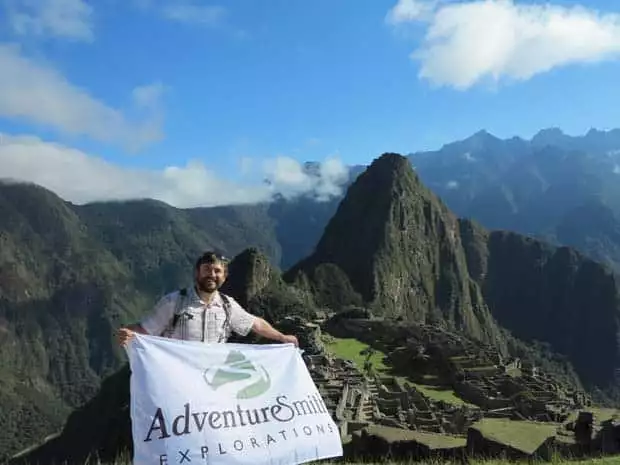
Despite the ravages of time, weather, earthquakes and human activity from the Spaniards to the present-day tourists and local communities, the fantastic creations of the Inca are still there. The Inca accomplished staggering feats of stonework, irrigation, engineering, city planning, food production, astronomy and industry upon one of the most beautiful and dramatic landscapes on earth. From their capital, Cusco, to their breadbasket, the Sacred Valley, to their jungle citadel, Machu Picchu, a visitor can explore the Inca fortresses, temples, farm terraces, towns, cemeteries, trails, pottery and metalwork with incredible intimacy and clarity.
AdventureSmith’s Machu Picchu Explorer itinerary allows a traveler to visit the major Inca sites and locales in a comfortable and time-effective way. I embarked on an expanded version of the itinerary in July.
Day 1 – Arrival in Lima, Peru
I arrived in Lima late at night, which is typical of most flights from the US. I was met at the airport by a helpful guide who provided me with a transfer to my hotel in the seaside Miraflores neighborhood. The Casa Andina Private Collection hotel was very comfortable for a quick overnight and provided an above-average breakfast in the morning.
Day 2 – Lima
My Lima guide, Dianna, picked me up at my hotel in the morning for a city tour. Deanna had 30 years of guiding experience in the city and was an outstanding and friendly resource with whom to explore this unfamiliar city. We drove through Miraflores and saw the large excavation project at the flat-topped pyramids called Huaca Pucllana, built by the Lima culture centuries before the Inca Empire. We passed into the San Isidro area, which was once fertile farmland and is now the financial district.
Lima has increasingly become known as a foodie hotspot where traditional Peruvian flavors are combined with international dishes.
Finally we reached the Old Town where we toured the St. Francis churches courtyards, catacombs and chapels. The main square holds a circa-1600s water fountain, the presidential palace and the Cathedral Church, which holds the remains of Francisco Pizarro. We visited the remarkable Larco Museum, which houses an extensive collection of pre-Inca and Inca items including pottery, weavings and jewelry. Lima, previously known throughout the world mainly for its famously gray skies, has increasingly become known as a foodie hotspot where traditional Peruvian flavors are combined with international dishes. I found this emerging reputation to be well warranted, as the food in Lima is excellent. At the Larco Museum there is a nice garden café where I enjoyed potatoes in yellow pepper sauce, beef, and the purple corn-based sweet drink called chicha morada.
I toured the bohemian Barranco neighborhood with its many shops, restaurants and artisan workshops, and drove along the expansive Costa Verde beach area back toward Miraflores. Surfers rode the breaks and para-gliders floated in the sky as the Pacific Ocean stretched into the gray horizon.
Lima is more interesting and complex than many travelers realize, and is well worth a day of exploration (and eating).
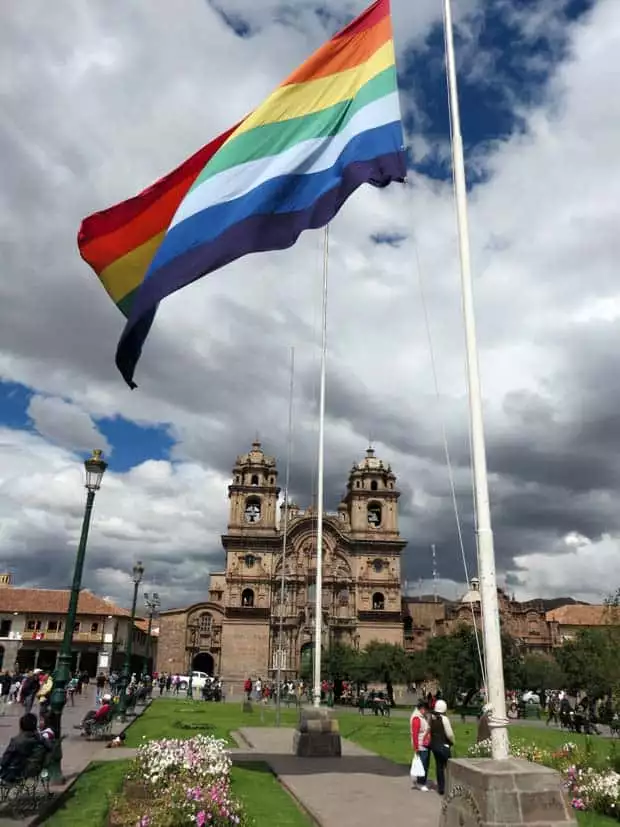
Day 3 – Cusco
I took the 1.5-hour flight to Cusco on a comfortable LAN Airlines jet. Get a window seat; it’s fun to rise above the coastal marine cloud layer and see the foothills of the Andes quickly rising into an endless expanse of rock. Sitting at about 11,000 feet elevation in an inter-Andean valley, Cusco was the Inca’s capital city and contains numerous ruins along with a well-preserved colonial history.
Directly from the airport I met my guide, Haydee, and began a half-day city tour. I noticed the altitude when breathing the thin air but was happy to avoid any problems from the elevation. First we visited Cusco’s main Cathedral with its impressively decorated chapels and dank catacombs. We walked through the streets noting the Inca walls in the bases of numerous contemporary buildings. The old, formidable stonework is so common that even humble gift shops, local banks or cafes will have original Inca blocks as their doorways, foundations or interior walls. We reached the most important Inca temple, Corikancha and marveled at the jaw-dropping craftsmanship (and lamented the destruction of most of the original temple and Spanish pilfering of the extensive silver and gold plating that once covered the entire structure). Haydee illuminated my experience with history and context as we walked. The Plaza de Armas is a vibrant square surrounded by historic buildings and filled with flowers, fountains and a flurry of people.
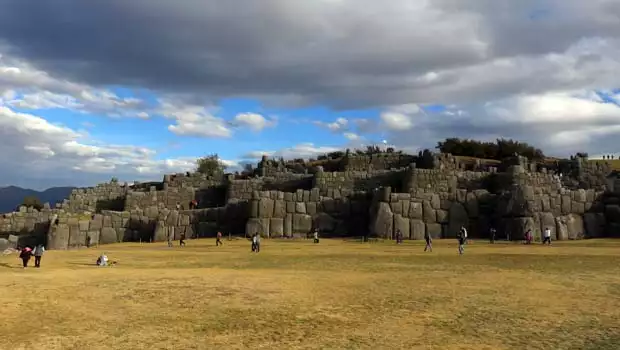
Perched on a hill above Cusco is Sacsayhuaman, a major earth and stone Inca site. In these ruins, car-sized stones are precisely fit together into three ascending levels that look like a sprawling flat-topped pyramid stretched across the ridgeline. It is no wonder that the Spanish first assumed the site was a fortress. In this place where the scale of the project overwhelms a visitor, perhaps the wildest part is that most of it is still covered by dirt. It is the first of many times during this trip where I experienced awe when considering what the Inca were able to accomplish without modern tools and machines. We investigated a nearby limestone formation where mummification was carried out under the gaze of a huge rock carving of a condor. A portion of the Inca Trail lay visible in the grove of eucalyptus trees nearby. As evening approached and the air grew cooler at the 12,000 foot elevation, we drove to a stone path that led us up a hill to the Temple of the Waters, a cleverly-built and elegant collection of water spouts, pools and niches used for rituals among the Inca elite.
I stayed in the hilly San Blas neighborhood at a comfortable 3-star hotel called Casa Andina Classic. San Blas is known for its artisans, and shops selling all types of wares abound. Along with the cobblestone streets, vendors, churches, plazas and many restaurants, the area has an exciting and eclectic feeling. After dark I explored the neighborhood. In one square beside a church, locals celebrated the Virgin Carmen with music, fireworks and dancing. I stopped into the strange and unique Hilario Mendivil Museum and store to see the artist’s well-known long-necked angel figures. Then, I finished the night with dinner at the renowned Cicciolina restaurant.
Day 4 – To the Sacred Valley
After a simple breakfast my guide picked me up for a short drive up to Awanacancha in the hills above Cusco. After taking in long views of the idyllic landscapes surrounding the city, we descended down into the Sacred Valley to Pisaq and then drove up the steep winding road to the Pisaq ruins. This stonework includes a mountaintop fort with Inca Trail links to nearby villages and extensive (10,000+) tombs with mummies in the hillside behind (most, but not all, have been pillaged for the gold ornaments). Facing the town of Pisaq is a huge dual set of terraces with the typical sophisticated irrigation systems. Haydee gave me ample time to explore the nooks and crannies of the beautiful complex.
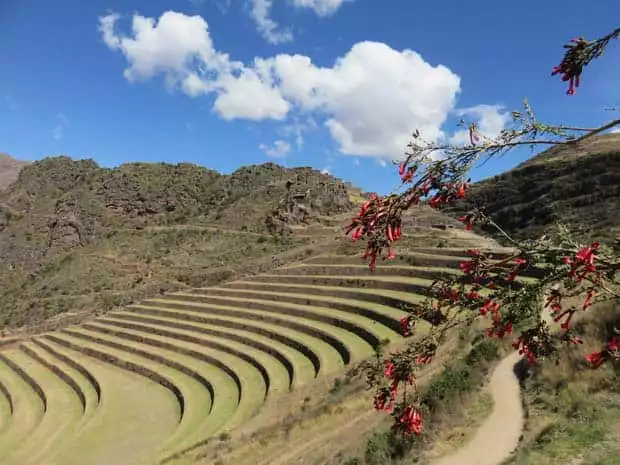
We drove back into Pisaq but our exit into town was blocked for the procession of the Virgin de Carmen celebration. We left our driver and walked through the town’s market and main square. I bought a fresh empanada by a large stone fire pit where cooks were preparing the night’s feast of pigs, guinea pigs and chickens. We met the parade and followed the decorated worshippers and band of musicians through town. When the procession was finished we met our driver and drove farther down the verdant Urubamba Valley.
In Urubamba town we stopped at beautiful Wayra Ranch for lunch. There, we sat at picnic tables in the shade and watched a live exhibition of the famous Peruvian horses while we ate a hearty gourmet lunch that included local corn, tamales, salad, beef heart, pork, rainbow trout, chicken, potatoes, chicha morada, gooseberries, desserts and more.
Before ending the day at my hotel we stopped into the well-regarding pottery studio of Pablo Seminario where I learned about his life and work and shopped for distinctive, Inca-inspired clay pots. That evening I relaxed at the lovely Sol y Luna hotel in Urubamba. The large property is covered in elaborate, well-loved gardens with meandering stone paths throughout. Along the paths are the guest cabins, which are elegant stone and wood buildings cozily set back into the colorful foliage. The hotel and grounds of the Sol y Luna were so pleasant and peaceful that I wanted to stay for a week—especially after I ate at their excellent restaurant that evening.
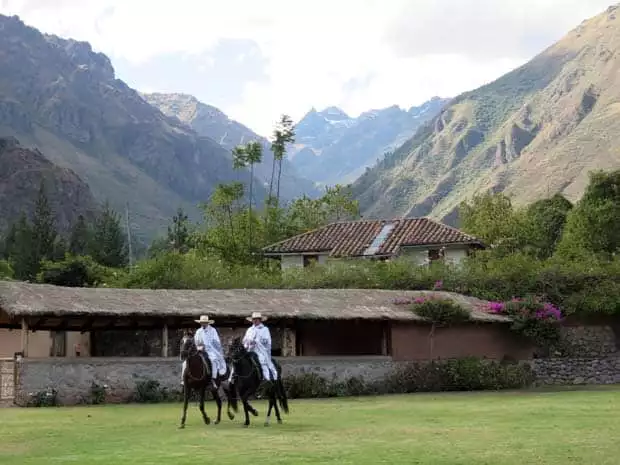
Day 5 – Sacred Valley
After a great breakfast at Sol y Luna I met my guide for a one hour drive up to Chinchero. This small town is not down in the Sacred Valley but up on the adjacent high plateau. Here, I toured the hilltop ruins of an Inca ceremonial site that looks toward the sacred mountains of Veronica and Salkantay. With perfectly clear blue skies I was able to see those distant mountains from this 12,000 foot vantage point. July is part of the cooler, drier season in this area, meaning the pastures surrounding Chinchero were all shades of brown, yellow, orange and pale green. Workers were carefully repairing sections of the ruins. Haydee explained the relevance and history of the Spanish church that was built on the Inca stonework. The village near this site is a humble place with dogs, sheep and even children roaming the narrow cobblestone streets. It is not uncommon here or in the villages of the Sacred Valley to see whole families farming their small farm plots beside their homes, sometimes with the help of an oxen team dragging a wooden plow. We went to a marketplace in this town well-known for the quality of its textiles to feed the alpacas, drink herbal tea and buy a few items from the vendors.

From Chinchero we set off across the plateau’s rolling farmland on bumpy dirt road to the Maras Salt Ponds. Here, in a valley where a salty spring flows, people have been “farming” salt since long before the Inca ruled this land. The tradition continues today with individuals or families tending their little “ponds” along a rocky ravine that contains thousands of them. The bright white crust of the salt lines each of the ponds where brown water sits evaporating in the sun. A delicate, complex system of thin water channels connects every single pond to the main spring source like veins in a body. Here and there, workers used sticks or hatchets to keep the water flow open from the salt’s constant accumulation. The famous Maras pink salt is just as valued a commodity as it was centuries ago.

We then set off for Moray, bumping across more dirt roads through pastureland as we drove. Tall mountain peaks lined the horizon and families herding sheep occasionally blocked our path. Moray is an unbelievable site that is home to three massive terraced circular depressions in the land. It is currently thought that this place was an agricultural laboratory where plant breeding, irrigation techniques and examination of farming microclimates were all investigated and improved by the Inca farmers. Visiting the site with a great guide was the key to my appreciation and amazement of that dramatic, alien-looking spot.
Visiting the Moray site with a great guide was the key to my appreciation and amazement of that dramatic, alien-looking spot.
From Moray it is just a short drive back into the Sacred Valley. On the western side of the Valley we stopped in the village Ollantaytambo. The town is located at the junction of two valleys, and a towering Inca fortress and royal residence lords over the town atop a steep terraced slope. This important Inca site is visually overwhelming, but even more difficult to grasp are the engineering feats required to place the huge stones in the Wall of the Six Monoliths. These rocks, evidently, were quarried from a high mountaintop across the valley, brought across the Urubamba River, and then hauled up the steep hill. Standing at the top, I could see the Inca Trail, the mountainside storehouses called Pinkuylluna and the entire town of Ollantaytambo. Everywhere, the buildings seemed to be in evident harmony with the topography and (my guide taught me) the movements of the Sun.

I spent the night at Sonesta Posada del Inca, which is located behind a church courtyard in the village of Yucay. This hotel is on the site of an old convent and is the oldest lodging in the Sacred Valley. There are rustic-looking buildings and grounds filled with gardens and comfortable patios. I had a Pisco Sour on a big chair by the garden and then had supper at their restaurant: chicken noodle soup and fresh trout with quinoa. The experience was immensely pleasant and, combined with my night at the nearby Sol y Luna hotel, left me with great memories of the hospitality and comfort available in the Sacred Valley.
Day 6 – Machu Picchu
Machu Picchu isn’t an easy place to get to, which is part of the reason why the Spanish never found it, so thank goodness for that. After breakfast at Yucay I drove with my guide to the train station at Ollantaytambo and took a very comfortable 1.5-hour trip along the descending Urubamba River to Aguas Calientes. The train ride features views of villages, the Inca Trail, valleys filled with farmland, ruins, towering mountain peaks and the gradual transition to the cloud forest temperate zone. In tiny Aguas Calientes it’s just a short walk from the train station to the bus station. There, I boarded a coach bus for the 20-minute drive up the steeply switchbacked road that climbs thousands of vertical feet out of the river valley to the entrance of Machu Picchu.
It is no exaggeration to state that while I had extensively studied photos and reading materials about Machu Picchu before my trip, I was nonetheless completely thunderstruck by the experience of being there.
It takes about 2.5-3 hours to sufficiently tour the prime sites at Machu Picchu with a good guide. We had a sunny day with few clouds, which allowed for views of the surrounding jungle-covered peaks and valleys. The citadel is a masterpiece of forethought, engineering, craftsmanship, aesthetic beauty and building in harmony with both nature and astronomy. It is no exaggeration to state that while I had extensively studied photos and reading materials about Machu Picchu before my trip, I was nonetheless completely thunderstruck by the experience of being there. After my guided tour ended I walked past the Guard House down the trail to the Inca Bridge. This “back door” entrance to Machu Picchu is a thin trail cut into a sheer cliff that drops straight down several thousand feet into the river valley below. The “Bridge” is a spot on the cliffside trail where the builders left a large gap and long pieces of wood are placed across it. It is hard to comprehend the risk taken by the people who carved this trail!
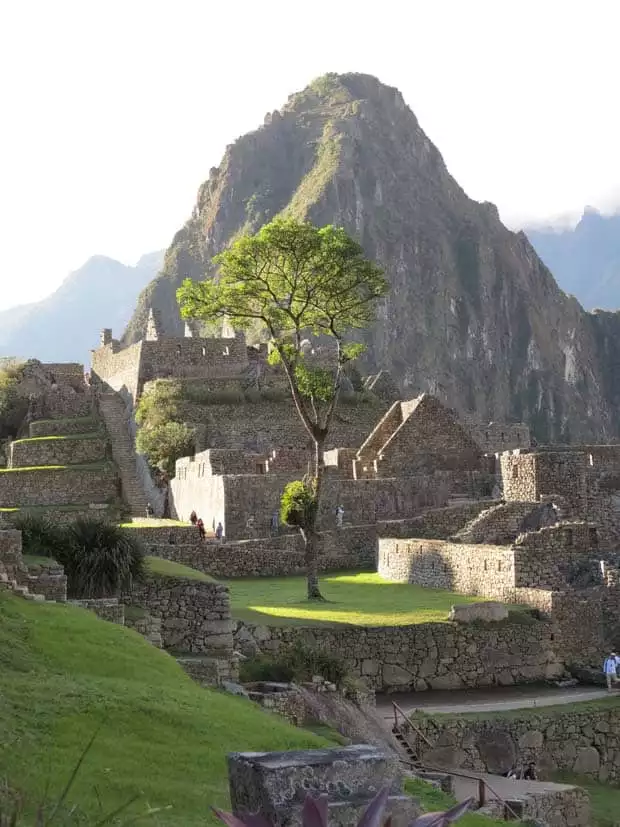
After taking the bus back down to Aguas Calientes I walked over to my beautiful hotel for the night, Inkaterra Pueblo Machu Picchu. The Inkaterra is a garden-filled property that houses a pool, an orchid garden, a hummingbird garden, waterfalls and patios. Cabins are sprinkled throughout, hidden by the vegetation. The rooms have a clean, old-world style that feels calming and peaceful, and the hotel service and staff are top-notch. I had a drink in their tasteful bar and a nice supper in the dining room.
Day 7 – Machu Picchu
I woke early to get back up to Machu Picchu. After learning so much during my guided tour the previous day, today would be my chance to explore on my own. The first thing I did was walk the trail to the Sun Gate (Intipunku), which took me about 30 minutes walking at a brisk pace. There, I sat on the stonework and soaked in the soft morning light as it warmed Machu Picchu and Huanya Picchu. After I’d descended back to the Guard House I simply sat on a grass terrace and took in the incredible atmosphere. I highly recommend taking time at Machu Picchu to just sit and process the surreal view. I tried to imagine what it may have looked like at the height of the Inca Empire.
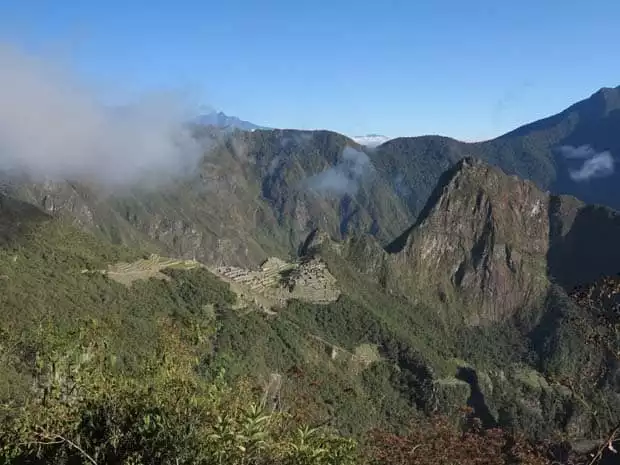
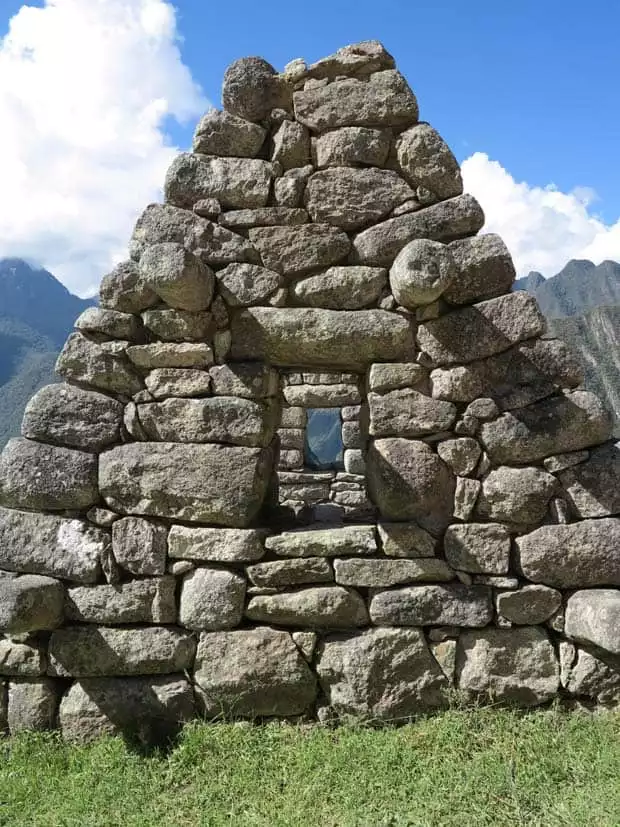
I had a 10am permit to hike the steep rock tower called Huayna Picchu. On the walk to the entrance I passed a family of llamas eating grass on the main courtyard. When one looks up at Huayna Picchu it seems impossible that there’d be a walkable trail to the top. But though it is somewhat precarious and very steep, the path is doable for most able-bodied people and very worthwhile. The hardest piece is the 50 yards nearest the top where the stone steps are each larger than normal and so steep that it is a little like climbing a ladder. At the top I was treated to 360-degree views of the landscape and a bird’s eye view of Machu Picchu.
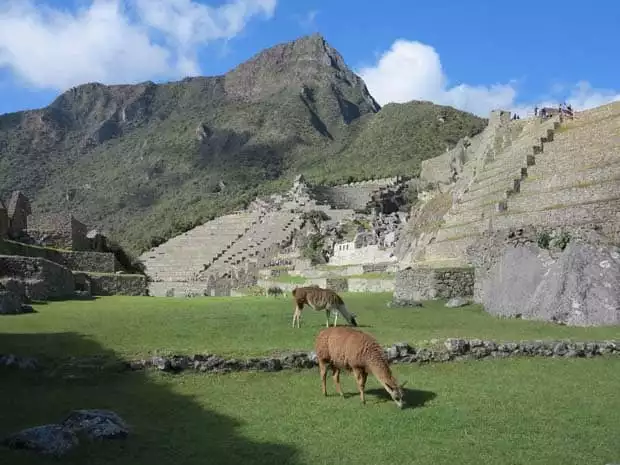

Most visitors will descend Huayna Picchu by the same trail they walked up on, but there are other (adventurous) options. I opted to descend the backside of Huayna Picchu towards the site called Gran Cavern (Temple of the Moon). To do this I had to walk down hundreds of very steep steps and climb down a wooden ladder that was about 30 feet tall. After down-climbing a long ways I finally reached the exquisite Temple of the Moon. The mysterious spot involves some of the finest stonework I’d seen at any Inca ruin, all tucked deep under a massive overhanging rock. While little is known about the Gran Cavern, it is obvious to any visitor that it was a sacred, important place. The walk through the forest back to Machu Picchu is lengthy but beautiful.
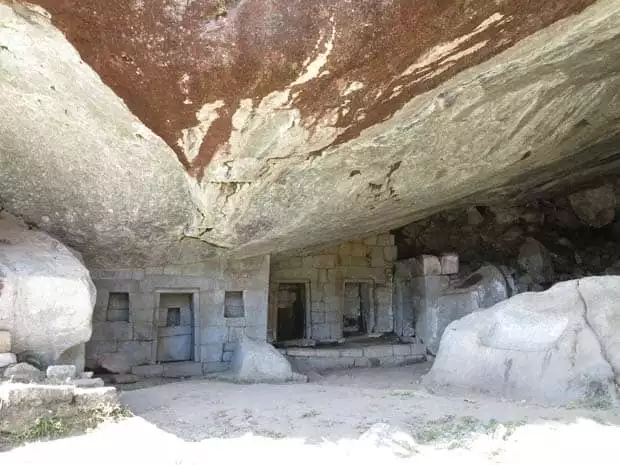
In the late afternoon I headed back down to Aguas Calientes to explore. It is a ramshackle little town but not without great beauty and an atmosphere of energy among the many tourists, backpackers, locals and vendors selling their colorful wares in the streets. Three bridges cross the river to connect the town and a large square is surrounded by hotels, bars and restaurants.
I took the train back to Ollantaytambo that evening and met my driver for the two-hour drive back to Cusco via Chinchero. It was a clear night, and with scarcely any light pollution in the area I was treated to great views of the stars and a vivid Milky Way. In Cusco I had a late dinner at the Italian eatery Incanto and stayed overnight at the well-appointed Aranwa Hotel. The hotel is a colonial mansion filled with original antiques and boasts outstanding service, accommodations and food.
Day 8 – Cusco
I had an afternoon flight to Lima and was determined to make the most of my remaining time in Cusco. I walked from my hotel to the San Pedro Market. The bustling market was a thrill and I explored for hours. Hundreds of locals filled the food stands to stand or sit down and enjoy their lunch. Vendors sold textiles and gifts in a rainbow of colors. The market is an ideal place to do some shopping before leaving Cusco.
Back in Lima I had a few hours so I indulged in yet one more Peruvian meal before my flight out. I visited one of the top restaurants in Lima, Madam Tusan, where the specialty is Chifa, a fusion of Peruvian and Chinese cooking styles. It would be the last of a long string of perfect meals I’d enjoy in Peru. Soon, I was in the airport waiting for my flight with a fully belly and a blur of happy memories winding through my thoughts.
For more photos and commentary from my trip, see my Machu Picchu Explorer Facebook album.
This Machu Picchu review was written by an AdventureSmith Explorations crew member. Read all AdventureSmith Expert Reviews for more trip reports, or contact one of our Adventure Specialists to learn more about these small ship cruises and wilderness adventures: 1-800-728-2875.
Comments will be moderated and will appear after they have been approved.